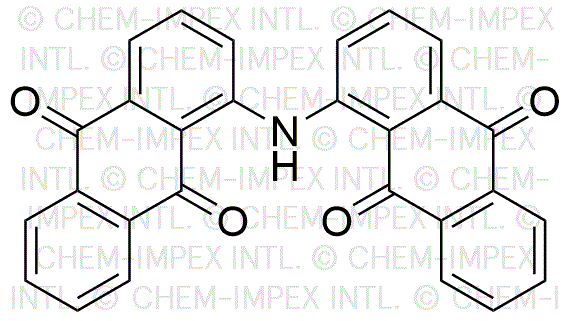1,1'-Iminodianthraquinone is widely utilized in research focused on:
- Dyes and Pigments: This compound is used in the production of high-performance dyes, particularly in textiles and coatings, due to its vibrant color and stability.
- Photovoltaic Cells: It serves as a key material in organic solar cells, enhancing their efficiency by improving light absorption and charge transport.
- Organic Electronics: The compound is integral in the development of organic semiconductors, which are crucial for flexible electronic devices and displays.
- Antioxidant Applications: Its antioxidant properties make it valuable in formulating products that require protection against oxidative stress, such as in cosmetics and food preservation.
- Research in Photochemistry: It is extensively studied for its photochemical properties, aiding in the development of new materials for light-driven applications, including sensors and catalysts.
General Information
Properties
Safety and Regulations
Applications
1,1'-Iminodianthraquinone is widely utilized in research focused on:
- Dyes and Pigments: This compound is used in the production of high-performance dyes, particularly in textiles and coatings, due to its vibrant color and stability.
- Photovoltaic Cells: It serves as a key material in organic solar cells, enhancing their efficiency by improving light absorption and charge transport.
- Organic Electronics: The compound is integral in the development of organic semiconductors, which are crucial for flexible electronic devices and displays.
- Antioxidant Applications: Its antioxidant properties make it valuable in formulating products that require protection against oxidative stress, such as in cosmetics and food preservation.
- Research in Photochemistry: It is extensively studied for its photochemical properties, aiding in the development of new materials for light-driven applications, including sensors and catalysts.
Documents
Safety Data Sheets (SDS)
The SDS provides comprehensive safety information on handling, storage, and disposal of the product.
Product Specification (PS)
The PS provides a comprehensive breakdown of the product’s properties, including chemical composition, physical state, purity, and storage requirements. It also details acceptable quality ranges and the product's intended applications.
Certificates of Analysis (COA)
Search for Certificates of Analysis (COA) by entering the products Lot Number. Lot and Batch Numbers can be found on a product’s label following the words ‘Lot’ or ‘Batch’.
*Catalog Number
*Lot Number
Certificates Of Origin (COO)
This COO confirms the country where the product was manufactured, and also details the materials and components used in it and whether it is derived from natural, synthetic, or other specific sources. This certificate may be required for customs, trade, and regulatory compliance.
*Catalog Number
*Lot Number
Safety Data Sheets (SDS)
The SDS provides comprehensive safety information on handling, storage, and disposal of the product.
DownloadProduct Specification (PS)
The PS provides a comprehensive breakdown of the product’s properties, including chemical composition, physical state, purity, and storage requirements. It also details acceptable quality ranges and the product's intended applications.
DownloadCertificates of Analysis (COA)
Search for Certificates of Analysis (COA) by entering the products Lot Number. Lot and Batch Numbers can be found on a product’s label following the words ‘Lot’ or ‘Batch’.
*Catalog Number
*Lot Number
Certificates Of Origin (COO)
This COO confirms the country where the product was manufactured, and also details the materials and components used in it and whether it is derived from natural, synthetic, or other specific sources. This certificate may be required for customs, trade, and regulatory compliance.


